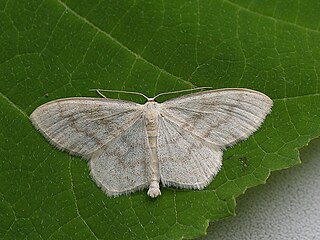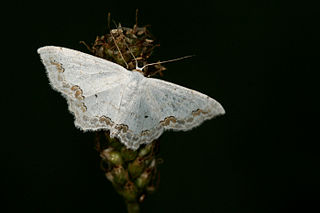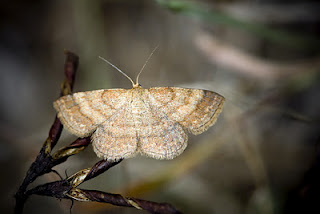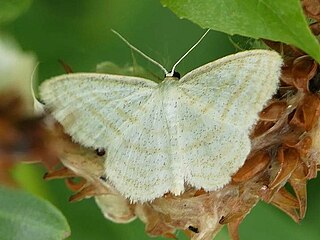
The cream wave is a moth of the family Geometridae. The species was first described by Adrian Hardy Haworth in 1809. It is found in forest and woodland regions, feeding on grasses and small plants such as dandelion.

Scopula imitaria, the small blood-vein, is a moth of the family Geometridae. It was first described by Jacob Hübner in 1799 and it is found throughout Europe and in North Africa.

Scopula immorata, the Lewes wave, is a moth of the family Geometridae. It is found throughout Europe and the Near East.

Scopula immutata, the lesser cream wave, is a moth of the family Geometridae. It was described by Carl Linnaeus in his 1758 10th edition of Systema Naturae. It is found throughout Europe.

Scopula ornata, the lace border, is a moth of the family Geometridae. The species was first described by Giovanni Antonio Scopoli in his 1763 Entomologia Carniolica. It is found in Europe, North Africa and the Near East.

Scopula limboundata, the large lace-border, is a moth of the family Geometridae. It was described by Adrian Hardy Haworth in 1809. It is found in North America east of the Rocky Mountains. There is a single and unconfirmed record from Great Britain.

Scopula incanata is a species of moth in the family Geometridae. It is found from north-eastern Europe and the Caucasus to southern Siberia and northern Mongolia.

Scopula turbidaria is a species of moth in the family Geometridae. It is found in France, Spain and Portugal. It is also found in North Africa.
Scopula adelpharia is a moth of the family Geometridae. It was described by Püngeler in 1894. It is found in North Africa, the Near East and Middle East.
Scopula pudicaria is a moth in the family Geometridae. It is found from north-eastern China to south-eastern Russia, Korea and Japan.

Scopula subpunctaria is a species of moth in the family Geometridae. It is found from northern and north-eastern China to the southern Palearctic realm.
Scopula prouti is a moth of the family Geometridae. It is found from north-eastern China to Korea, Japan and south-eastern Russia.
Scopula indicataria is a moth of the family Geometridae. It is found in China, Korea, Japan and Russia.

Scopula corrivalaria is a moth of the family Geometridae. It is found from Japan, Korea, China and the Russian Far East through Siberia and Russia to western Europe. In Europe, it ranges from northern Central Europe to the Mediterranean. The habitat consists of marshes and wet meadows.
Scopula eburneata is a moth of the family Geometridae. It is found in Brazil, French Guiana, Jamaica and southern North America, including Texas.

Scopula submutata, the Mediterranean lace border, is a moth of the family Geometridae. It is found in southern Europe, North Africa and the Near East. The habitat consists of open, dry grassland and rocky slopes.
Scopula pratana is a moth of the family Geometridae. It is found in North Africa, the Canary Islands, the Near East and Yemen.

Scopula quadrilineata, commonly known as the four-lined wave, is a species of moth in the family Geometridae. It is found in North America, from Nova Scotia to Saskatchewan and bordering areas of the United States, south in the east to North Carolina. It has also been recorded in British Columbia.
Scopula ochraceata is a moth of the family Geometridae. It is found in Bulgaria, North Macedonia, Greece, Turkey, the Near East, southern Russia and Ukraine.

Scopula umbelaria is a moth of the family Geometridae described by Jacob Hübner in 1813. It is found in the Benelux, France, Italy, Germany, Switzerland, Austria, the Czech Republic, Slovakia, Hungary, Slovenia, former Yugoslavia, Romania, Poland and Russia. In the east, the range extends to the eastern part of the Palearctic realm.












